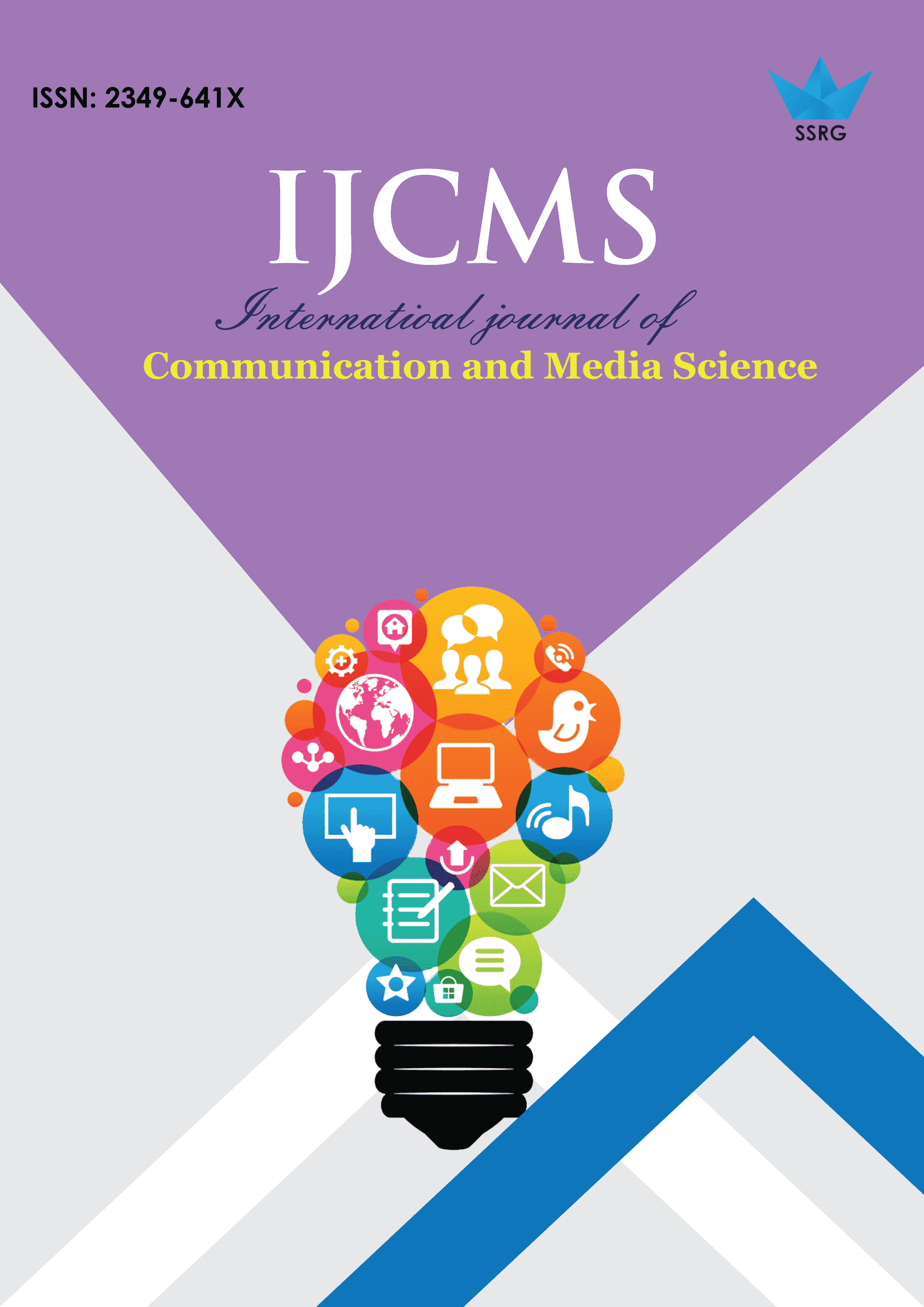Whats…App at Work? Instant Messaging Improves Professional Well-Being

| International Journal of Communication and Media Science |
| © 2019 by SSRG - IJCMS Journal |
| Volume 6 Issue 1 |
| Year of Publication : 2019 |
| Authors : Concetta Papapicco |
How to Cite?
Concetta Papapicco, "Whats…App at Work? Instant Messaging Improves Professional Well-Being," SSRG International Journal of Communication and Media Science, vol. 6, no. 1, pp. 17-23, 2019. Crossref, https://doi.org/10.14445/2349641X/IJCMS-V6I1P103
Abstract:
Whatsapp, instant messaging application, has radically transformed communication practices in different contexts. One of the most permeable contexts of virtual communication is the working environment. The study, with a positive view of analyzing the potentials of new media, aims to demonstrate how a Whatsapp group can be a support to network in helping professions, starting from the hypothesis that instant support, albeit virtual, from the team, it can be a useful facilitator. To evaluate this hypothesis, the Whatsapp communication group of operators of an Italian nursing home are analyzed in the research. The use of qualitative-quantitative methodologies, including Social Network Analysis (Wolfe, 1997), Sentiment Analysis (Pang & Lee, 2008) and Diatextual Analysis (Manuti & Mininni, 2017), allows to analyze how the virtual group can be an innovative way to resolve critical professional situations and how interactions, studied through a Social Network Analysis, can be predictive of the structuring of the online working group. Specifically, in the study 2237 conversational shifts of an Italian nurse house Whatsapp group were analyzed, from which three situations characterizing the help professions were extracted: the management of emergencies, decision making and problem solving. The positive sentiment shows that Whatsapp is a facilitator for organizational well-being.
Keywords:
Whatsapp group, Positive Psychology of new media, quanti-qualitative methodologies, help professions.
References:
[1] Acton, B., & Koum, J. (2014). WhatsApp blog. Retrieved from http://blog.whatsapp.com/
[2] Baiocco, R. (2004). Il rischio psicosociale nelle professioni di aiuto: la sindrome del burnout negli operatori sociali,
medici, infermieri, fisioterapisti, psicologi, psicoterapeuti e religiosi. Edizioni Erickson.
[3] Bouhnik, D., Deshen, M., & Gan, R. (2014). WhatsApp goes to school: Mobile instant messaging between teachers and students. Journal of Information Technology Education: Research, 13(1), 217-231.
[4] Church, K., & De Oliveira, R. (2013, August). What's up with whatsapp?: comparing mobile instant messaging behaviors with traditional SMS. In Proceedings of the 15th international conference on Human-computer interaction with mobile devices and services (pp. 352-361). ACM.
[5] Eco, U. (2011). Apocalittici e integrati: comunicazioni di massa e teorie della cultura di massa. Giunti.
[6] Ellis, D., Oldridge, R., & Vasconcelos, A. (2004). Community and virtual community. Annual review of information science and technology, 38, 145-188.
[7] Gandini, T. (2005). Le competenze e la valorizzazione del patrimonio umano in sanità. Una proposta metodologica per definire le competenze dell'infermiere con funzioni di coordinamento (Vol. 13). FrancoAngeli.
[8] Hall, D. T. (2002). Protean careers in and out of organizations. Thousand Oaks, CA: Sage.
[9] Hall, D. T., & Mirvis, P. H. (1994). Careers as lifelong learning. In A. Howard (Ed.), The changing nature of work. San Francisco: Jossey-Bass, in press.
[10] Hall, D. T., & Mirvis, P. H. (1994b). The new workplace and older workers. In J. A. Auerbach & J. C. Welsh (Eds.), Aging and competition: Rebuilding the U.S. workforce (pp. 58–93). Washington, DC: The National Council on the Aging, Inc., and the National Planning Association.
[11] Johnston, M. J., King, D., Arora, S., Behar, N., Athanasiou, T., Sevdalis, N., & Darzi, A. (2015). Smartphones let surgeons know WhatsApp: an analysis of communication in emergency surgical teams. The American Journal of Surgery, 209(1), 45-51.
[12] Manuti, A. & Mininni, G. (2017). A rose is more than a rose … the diatextual constitution of subjects and objects. De Gruyter Mouton, 37 (2): 243-263.
[13] Murero, M. (2014). Comunicazione post-digitale. Teoria interdigitale e mobilità interconnessa. libreriauniversitaria. it Edizioni.
[14] O'Hara, K. P., Massimi, M., Harper, R., Rubens, S., & Morris, J. (2014, February). Everyday dwelling with WhatsApp. In Proceedings of the 17th ACM conference on Computer supported cooperative work & social computing (pp. 1131-1143). ACM.
[15] Pang, B., & Lee, L. (2008). Opinion mining and sentiment analysis. Foundations and trends in information retrieval, 2(1-2), 1-135.
[16] Papapicco, C., Scardigno, R., Mininni, G. (2017). “What‟s the meaning of…”? : Virtual communities as dialogical cultures in learning Italian. Rcic‟17, vol. 6 n.1, pp. 321-326.
[17] Prensky, M. (2001). Digital natives, digital immigrants part 1. On the horizon, 9(5), 1-6.
[18] Quatera, I. & Papapicco, C. (2018). BEING LINK-ED: AGAPIC ACTION IN THE COMMUNITIES OF ITALIAN EXPATS. SocialOne, 163-172.
[19] Rota, A. (2017). L‟intimazione del licenziamento nell‟era digitale: dalla notificazione a mezzo raccomandata all‟invio tramite WhatsApp. Labour & Law Issues, 3(2), 25-47.
[20] Veneroni, L., Ferrari, A., Acerra, S., Massimino, M., & Clerici, C. A. (2015). Considerazioni sull‟uso di WhatsApp nellacomunicazione e relazione medicopaziente. Recenti Progressi in Medicina, 106(7), 331-336.
[21] Wallace, P. (2015). The psychology of the Internet. Cambridge University Press.
[22] Wenger E. (2006). Comunità di pratica. Apprendimento, significato, identità. Milano: Raffaello Cortina.
[23] Wolfe, A. W. (1997). Social network analysis: Methods and applications. American Ethnologist, 24(1), 219-220.
[24] Seligman, M. E., & Csikszentmihalyi, M. (2014). Positive psychology: An introduction. In Flow and the foundations of positive psychology (pp. 279-298). Springer, Dordrecht.

 10.14445/2349641X/IJCMS-V6I1P103
10.14445/2349641X/IJCMS-V6I1P103